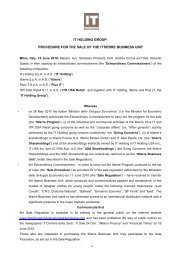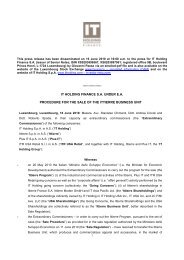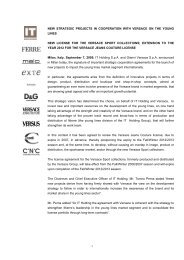You also want an ePaper? Increase the reach of your titles
YUMPU automatically turns print PDFs into web optimized ePapers that Google loves.
<strong>IT</strong> HOLDING S.p.A. Notes to the consolidated financial statements for the year ended December 31, 2003<br />
Actuarial gains and losses that arise subsequent to January 1, 2001 in calculating the Group’s obligation with<br />
reference to the termination leaving indemnity for Italian employees (so called TFR) are not deferred and are charged<br />
to the income statement of the period in which they are calculated.<br />
Equity and equity related compensation benefit<br />
The Group had a stock option program which has been abandoned in 2002 and no option rights have been given or<br />
exercised in 2002 or 2003.<br />
Financial instruments<br />
Financial instruments are presented according to IAS 39. Accordingly, financial assets, to the extent relevant to the <strong>IT</strong><br />
<strong>Holding</strong> Group, are classified as follows:<br />
held for trading;<br />
loans and receivables.<br />
Financial assets held for trading are classified as current asset and are stated at fair value, with any resultant gain or<br />
loss recognized in the income statement.<br />
The fair value of the financial assets is determined through reference to quoted market prices at the balance sheet date.<br />
If there are no market values available for the financial assets, the value is determined by reputable financial<br />
institutions on the basis of market conditions.<br />
Subsequent measurement of loans and receivables is at amortized cost using the effective interest method or historical<br />
cost on whether the assets have a fixed or non-fixed maturity.<br />
Provisions<br />
A provision is recognized in the balance sheet when the Group has a legal or constructive obligation as a result of a<br />
past event, and it is probable that an outflow of economic benefits will be required to settle the obligation.<br />
If the effect is material, provisions are determined by discounting the expected future cash flows at a pre-tax rate that<br />
reflects current market assessments of the time value of money and, where appropriate, the risks specific to the<br />
liability.<br />
Agents’ termination benefits<br />
Agents’ termination benefits are calculated on the basis of the charge to be paid on the termination of agency<br />
contracts in compliance with law and other relevant factors such as historical data, the average length of the relation<br />
with the agents and their turnover.<br />
Tax provision<br />
The tax provision reflects estimated contingent tax liabilities that some Group companies may have to pay following<br />
the tax disputes currently pending with the tax authorities.<br />
Returns on sales<br />
The provision for returns on sales, set up to cover the unrealized profit arising from the difference between the sales<br />
value of possible returns to be received after year end, but pertaining to the year, and their estimated recovery value.<br />
Recognition of revenues<br />
Revenues from the sale of products are recognized on the transfer of ownership to third parties. Royalties are<br />
recognized at the time of sale of the licensed products and, in accordance with industry practice, are included in<br />
revenues. Should any product return or is expected to return or any commercial discount be recognized, the relevant<br />
value reduces revenues arising from the sale of goods. Cash discounts are recognized as financial costs.<br />
Rental income from investment property is recognized in the income statement on a straight-line basis over the term<br />
of the lease.<br />
F- 54






